Abstract
Hysterotomy-derived piglets were kept in gnotobiotic isolators and artificially colonized at 7 days of age with an adult bovine enteric microflora. At 3 weeks of age, the pigs were transferred to conventional experimental accommodation and weaned, either onto a solid diet that had been associated with field cases of typhlocolitis in pigs or onto a solid control diet. At necropsy at 5 weeks of age, groups of pigs fed the diet associated with field cases of typhlocolitis were found to have developed typhlocolitis. This was absent from the groups fed the control diet. The typhlocolitis was characterized by attaching and effacing lesions typical of those described following experimental inoculation of various species with enteropathogenic Escherichia coli. A nonverocytotoxic, eae probe-positive E. coli serotype O116 was isolated from pigs on the colitis-associated diet but not from any of the pigs on the control diet. Coliform bacteria attached to the colonic lesions reacted with polyclonal antiserum to E. coli O116 in an immunoperoxidase assay of histological sections of affected tissue. No reaction with this antiserum was observed in corresponding tissue sections taken from pigs on the control diet. No colon lesions were observed in germfree pigs fed either of the diets. It is postulated that proliferation and possibly expression of pathogenicity of the attaching and effacing E. coli responsible for the lesions are strongly influenced by diet.
Full text
PDF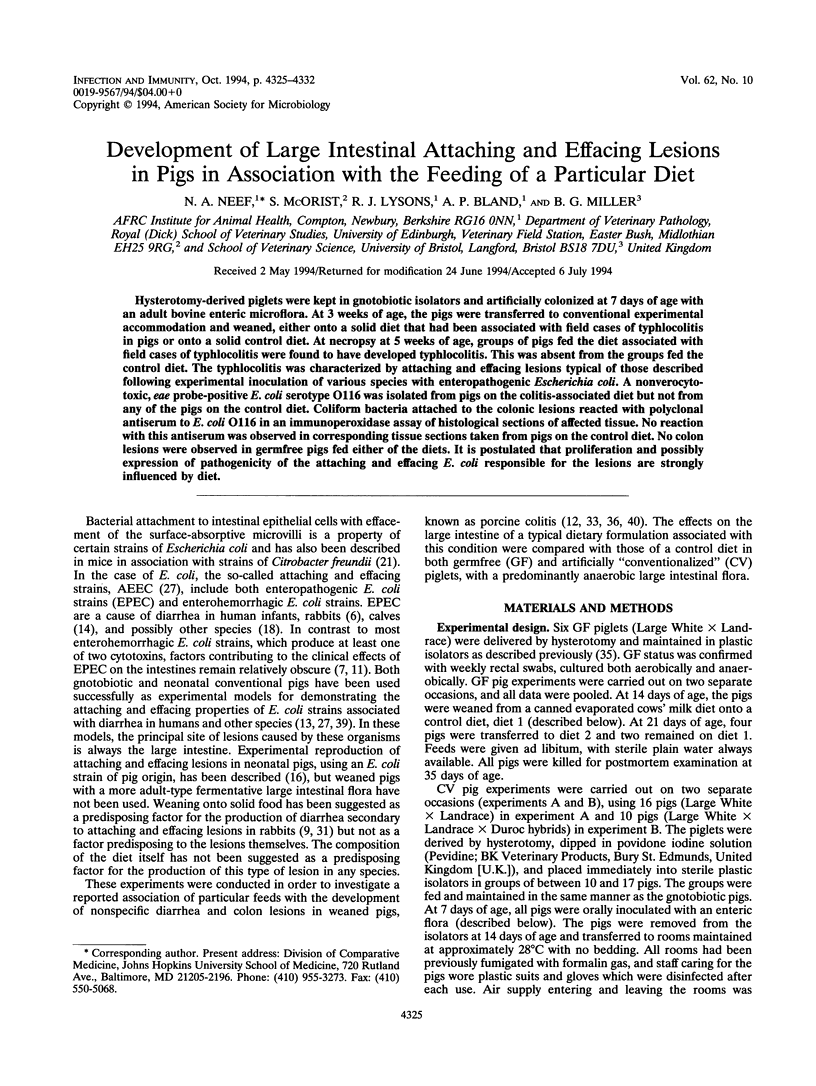
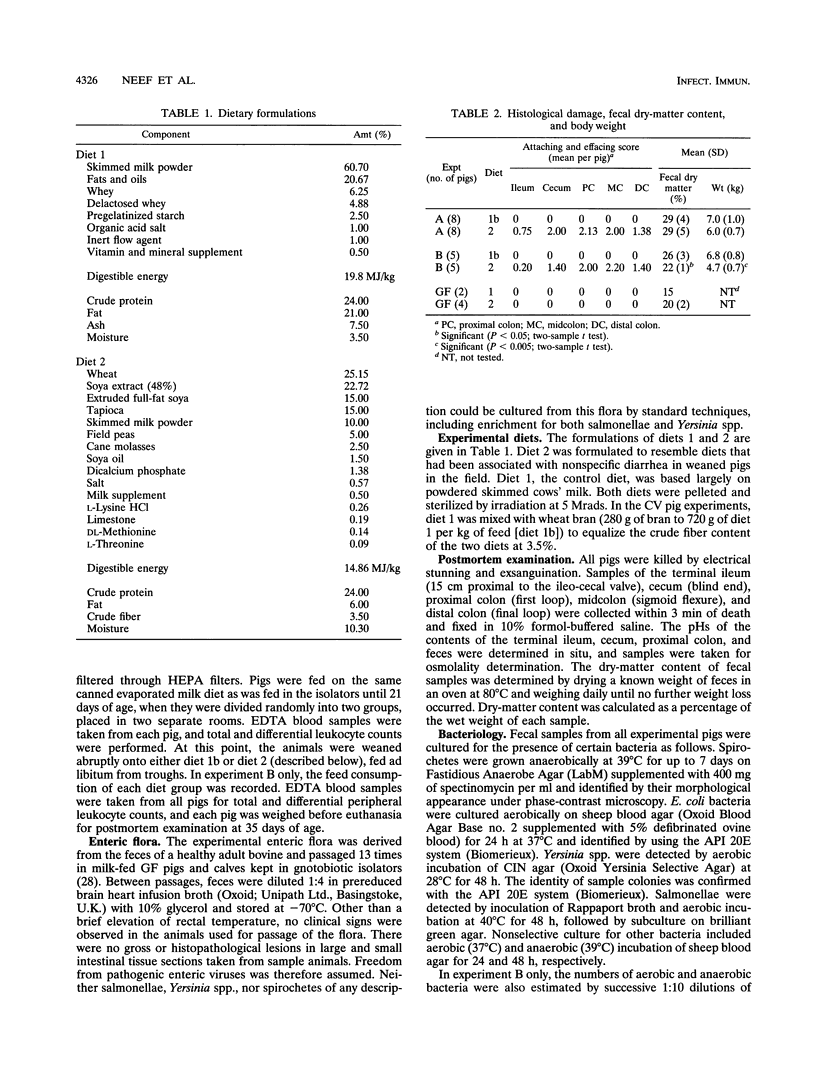
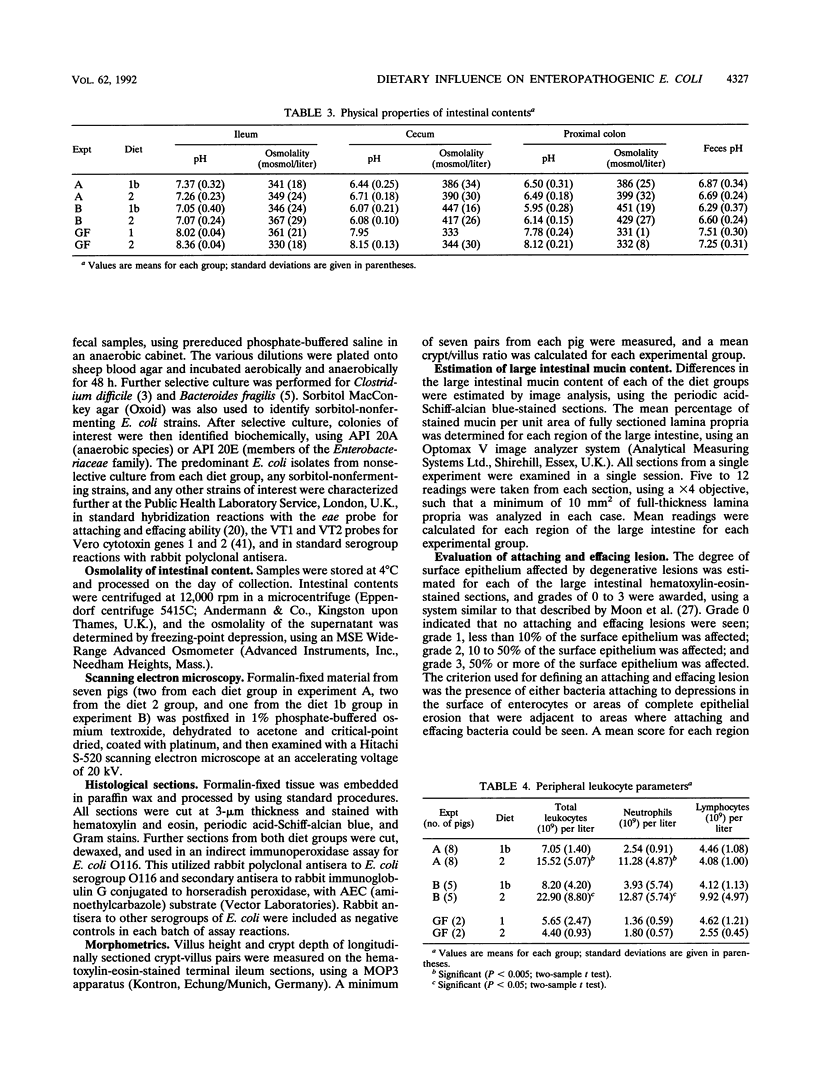
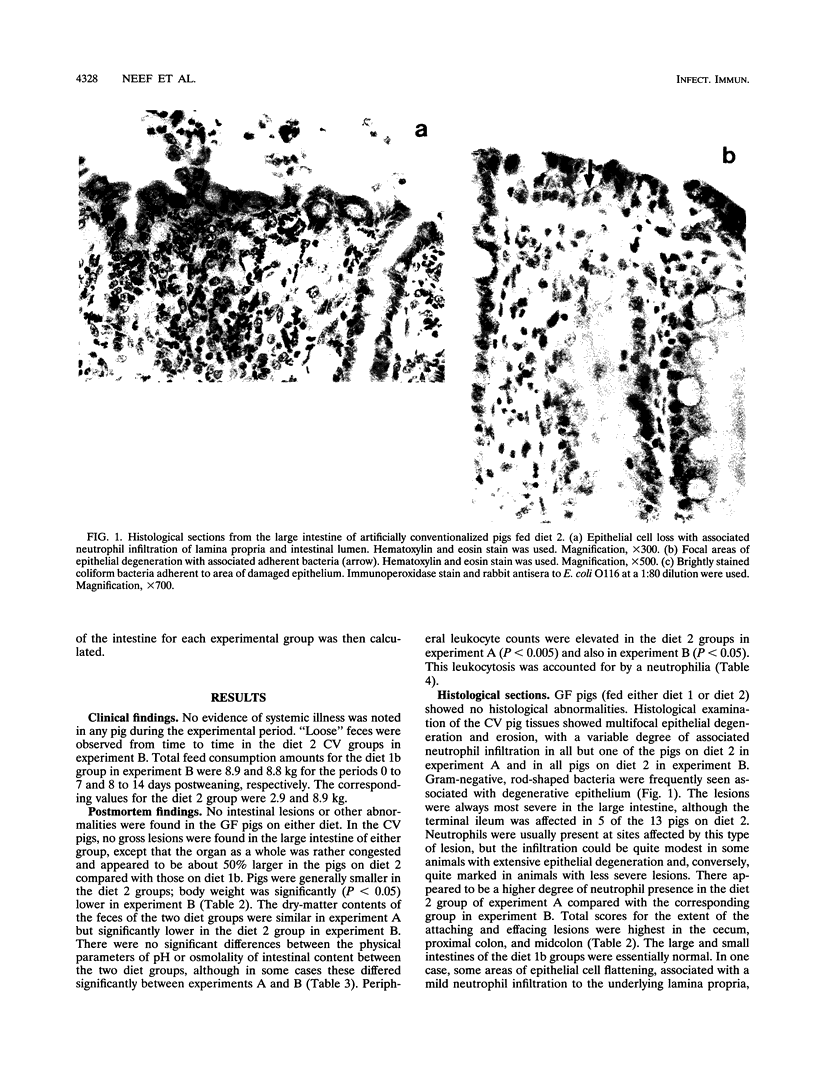
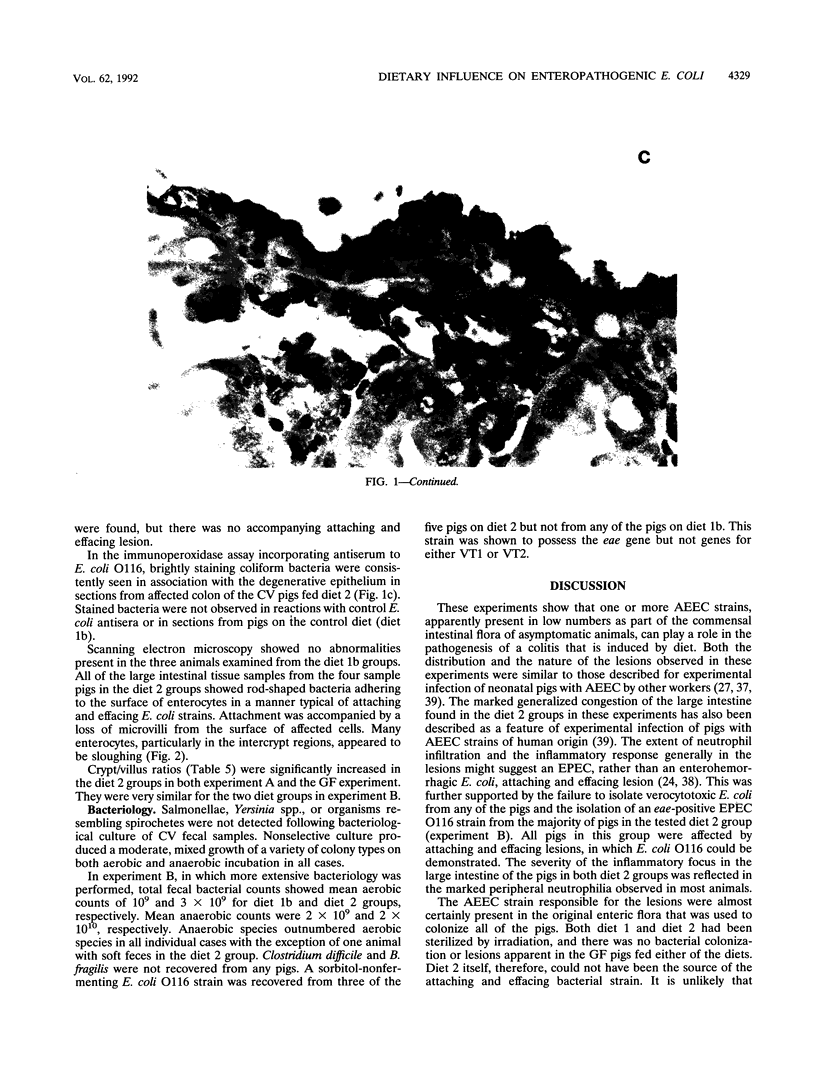
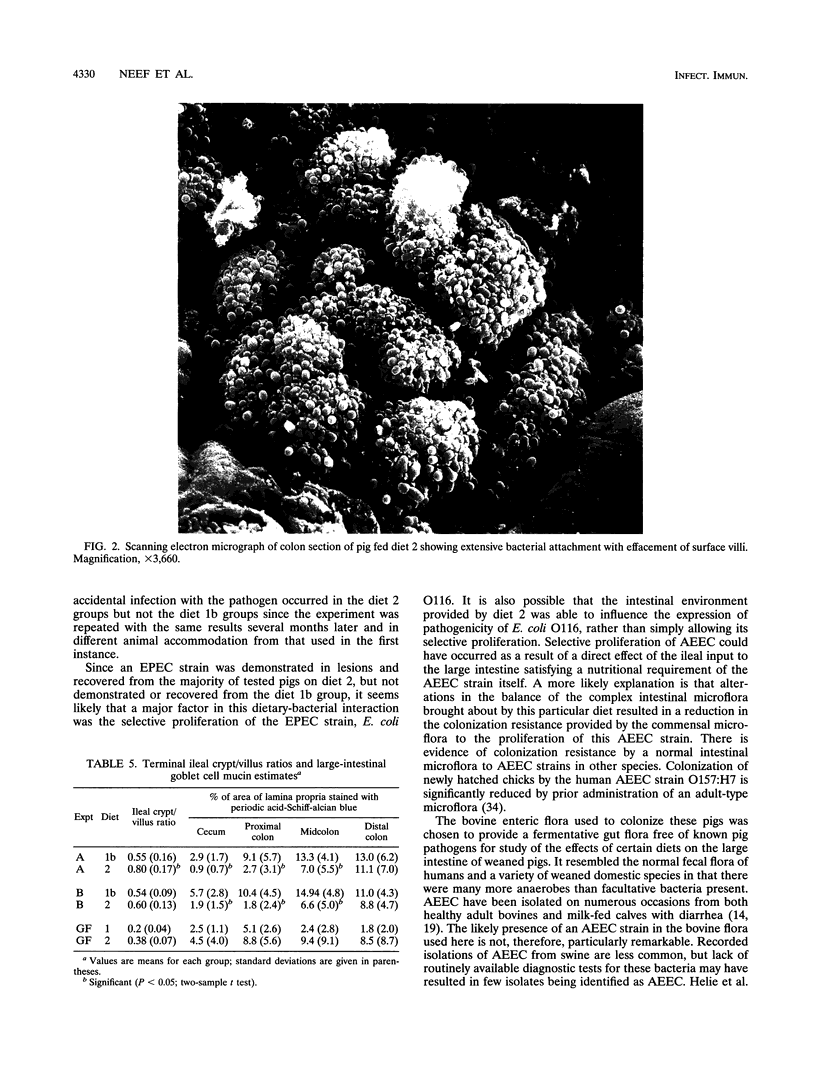


Images in this article
Selected References
These references are in PubMed. This may not be the complete list of references from this article.
- Argenzio R. A., Meuten D. J. Short-chain fatty acids induce reversible injury of porcine colon. Dig Dis Sci. 1991 Oct;36(10):1459–1468. doi: 10.1007/BF01296816. [DOI] [PubMed] [Google Scholar]
- Aspinall S. T., Hutchinson D. N. New selective medium for isolating Clostridium difficile from faeces. J Clin Pathol. 1992 Sep;45(9):812–814. doi: 10.1136/jcp.45.9.812. [DOI] [PMC free article] [PubMed] [Google Scholar]
- Border M., Firehammer B. D., Shoop D. S., Myers L. L. Isolation of Bacteroides fragilis from the feces of diarrheic calves and lambs. J Clin Microbiol. 1985 Mar;21(3):472–473. doi: 10.1128/jcm.21.3.472-473.1985. [DOI] [PMC free article] [PubMed] [Google Scholar]
- Cantey J. R., Blake R. K. Diarrhea due to Escherichia coli in the rabbit: a novel mechanism. J Infect Dis. 1977 Mar;135(3):454–462. doi: 10.1093/infdis/135.3.454. [DOI] [PubMed] [Google Scholar]
- Collins J. E., Bergeland M. E., Myers L. L., Shoop D. S. Exfoliating colitis associated with enterotoxigenic Bacteroides fragilis in a piglet. J Vet Diagn Invest. 1989 Oct;1(4):349–351. doi: 10.1177/104063878900100413. [DOI] [PubMed] [Google Scholar]
- Coussement W., Ducatelle R., Charlier G., Okerman L., Hoorens J. Pathology of experimental colibacillosis in rabbits. Zentralbl Veterinarmed B. 1984 Feb;31(1):64–72. doi: 10.1111/j.1439-0450.1984.tb01282.x. [DOI] [PubMed] [Google Scholar]
- Donnenberg M. S., Kaper J. B. Enteropathogenic Escherichia coli. Infect Immun. 1992 Oct;60(10):3953–3961. doi: 10.1128/iai.60.10.3953-3961.1992. [DOI] [PMC free article] [PubMed] [Google Scholar]
- Duncan A. L., Lysons R. J. Diagnosis of colitis in pigs. Vet Rec. 1987 Oct 31;121(18):430–430. doi: 10.1136/vr.121.18.430-a. [DOI] [PubMed] [Google Scholar]
- Hall G. A., Chanter N., Bland A. P. Comparison in gnotobiotic pigs of lesions caused by verotoxigenic and non-verotoxigenic Escherichia coli. Vet Pathol. 1988 May;25(3):205–210. doi: 10.1177/030098588802500304. [DOI] [PubMed] [Google Scholar]
- Hall G. A., Reynolds D. J., Chanter N., Morgan J. H., Parsons K. R., Debney T. G., Bland A. P., Bridger J. C. Dysentery caused by Escherichia coli (S102-9) in calves: natural and experimental disease. Vet Pathol. 1985 Mar;22(2):156–163. doi: 10.1177/030098588502200210. [DOI] [PubMed] [Google Scholar]
- Helie P., Morin M., Jacques M., Fairbrother J. M. Experimental infection of newborn pigs with an attaching and effacing Escherichia coli O45:K"E65" strain. Infect Immun. 1991 Mar;59(3):814–821. doi: 10.1128/iai.59.3.814-821.1991. [DOI] [PMC free article] [PubMed] [Google Scholar]
- Heppell L. M., Sissons J. W., Banks S. M. Sensitisation of preruminant calves and piglets to antigenic protein in early weaning diets: control of the systemic antibody responses. Res Vet Sci. 1989 Sep;47(2):257–262. [PubMed] [Google Scholar]
- Janke B. H., Francis D. H., Collins J. E., Libal M. C., Zeman D. H., Johnson D. D. Attaching and effacing Escherichia coli infections in calves, pigs, lambs, and dogs. J Vet Diagn Invest. 1989 Jan;1(1):6–11. doi: 10.1177/104063878900100104. [DOI] [PubMed] [Google Scholar]
- Janke B. H., Francis D. H., Collins J. E., Libal M. C., Zeman D. H., Johnson D. D., Neiger R. D. Attaching and effacing Escherichia coli infection as a cause of diarrhea in young calves. J Am Vet Med Assoc. 1990 Mar 15;196(6):897–901. [PubMed] [Google Scholar]
- Jerse A. E., Yu J., Tall B. D., Kaper J. B. A genetic locus of enteropathogenic Escherichia coli necessary for the production of attaching and effacing lesions on tissue culture cells. Proc Natl Acad Sci U S A. 1990 Oct;87(20):7839–7843. doi: 10.1073/pnas.87.20.7839. [DOI] [PMC free article] [PubMed] [Google Scholar]
- Johnson E., Barthold S. W. The ultrastructure of transmissible murine colonic hyperplasia. Am J Pathol. 1979 Nov;97(2):291–313. [PMC free article] [PubMed] [Google Scholar]
- Jones M. A., Hunter D. Isolation of Clostridium difficile from pigs. Vet Rec. 1983 Mar 12;112(11):253–253. doi: 10.1136/vr.112.11.253. [DOI] [PubMed] [Google Scholar]
- Kenworthy R., Allen W. D. The significance of Escherichia Coli to the young pig. J Comp Pathol. 1966 Jan;76(1):31–44. doi: 10.1016/0021-9975(66)90045-4. [DOI] [PubMed] [Google Scholar]
- Levine M. M. Escherichia coli that cause diarrhea: enterotoxigenic, enteropathogenic, enteroinvasive, enterohemorrhagic, and enteroadherent. J Infect Dis. 1987 Mar;155(3):377–389. doi: 10.1093/infdis/155.3.377. [DOI] [PubMed] [Google Scholar]
- Moon H. W., Whipp S. C., Argenzio R. A., Levine M. M., Giannella R. A. Attaching and effacing activities of rabbit and human enteropathogenic Escherichia coli in pig and rabbit intestines. Infect Immun. 1983 Sep;41(3):1340–1351. doi: 10.1128/iai.41.3.1340-1351.1983. [DOI] [PMC free article] [PubMed] [Google Scholar]
- Neef N. A., Lysons R. J., Trott D. J., Hampson D. J., Jones P. W., Morgan J. H. Pathogenicity of porcine intestinal spirochetes in gnotobiotic pigs. Infect Immun. 1994 Jun;62(6):2395–2403. doi: 10.1128/iai.62.6.2395-2403.1994. [DOI] [PMC free article] [PubMed] [Google Scholar]
- Peeters J. E., Charlier G. J., Halen P. H. Pathogenicity of attaching effacing enteropathogenic Escherichia coli isolated from diarrheic suckling and weanling rabbits for newborn rabbits. Infect Immun. 1984 Dec;46(3):690–696. doi: 10.1128/iai.46.3.690-696.1984. [DOI] [PMC free article] [PubMed] [Google Scholar]
- Reiter B. Review of the progress of dairy science: antimicrobial systems in milk. J Dairy Res. 1978 Feb;45(1):131–147. doi: 10.1017/s0022029900016290. [DOI] [PubMed] [Google Scholar]
- Smith W. J., Nelson E. P. Grower scour/non-specific colitis. Vet Rec. 1987 Oct 3;121(14):334–334. doi: 10.1136/vr.121.14.334-b. [DOI] [PubMed] [Google Scholar]
- Tavernor W. D., Trexler P. C., Vaughan L. C., Jones D. G. The production of gnotobiotic piglets and calves by hysterotomy under general anaesthesia. Vet Rec. 1971 Jan 2;88(1):10–14. doi: 10.1136/vr.88.1.10. [DOI] [PubMed] [Google Scholar]
- Tzipori S., Gibson R., Montanaro J. Nature and distribution of mucosal lesions associated with enteropathogenic and enterohemorrhagic Escherichia coli in piglets and the role of plasmid-mediated factors. Infect Immun. 1989 Apr;57(4):1142–1150. doi: 10.1128/iai.57.4.1142-1150.1989. [DOI] [PMC free article] [PubMed] [Google Scholar]
- Tzipori S., Karch H., Wachsmuth K. I., Robins-Browne R. M., O'Brien A. D., Lior H., Cohen M. L., Smithers J., Levine M. M. Role of a 60-megadalton plasmid and Shiga-like toxins in the pathogenesis of infection caused by enterohemorrhagic Escherichia coli O157:H7 in gnotobiotic piglets. Infect Immun. 1987 Dec;55(12):3117–3125. doi: 10.1128/iai.55.12.3117-3125.1987. [DOI] [PMC free article] [PubMed] [Google Scholar]
- Tzipori S., Wachsmuth K. I., Smithers J., Jackson C. Studies in gnotobiotic piglets on non-O157:H7 Escherichia coli serotypes isolated from patients with hemorrhagic colitis. Gastroenterology. 1988 Mar;94(3):590–597. doi: 10.1016/0016-5085(88)90228-4. [DOI] [PubMed] [Google Scholar]
- Wilkinson J. D., Wood E. N. Grower scour/non-specific colitis. Vet Rec. 1987 Oct 24;121(17):406–406. doi: 10.1136/vr.121.17.406-b. [DOI] [PubMed] [Google Scholar]
- Willshaw G. A., Smith H. R., Scotland S. M., Field A. M., Rowe B. Heterogeneity of Escherichia coli phages encoding Vero cytotoxins: comparison of cloned sequences determining VT1 and VT2 and development of specific gene probes. J Gen Microbiol. 1987 May;133(5):1309–1317. doi: 10.1099/00221287-133-5-1309. [DOI] [PubMed] [Google Scholar]





